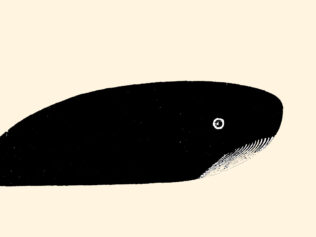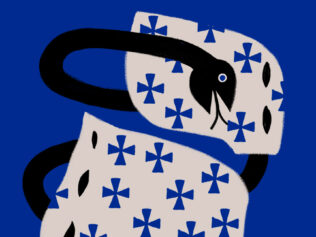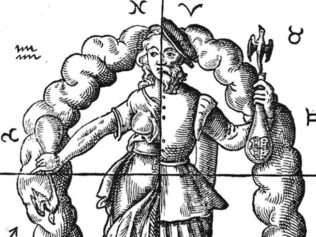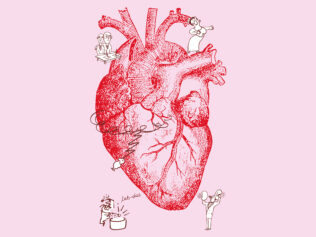
Western medicine has perfected diagnosing and treating the symptoms of heart disease thanks to ever-improving technologies. However, help can be given much earlier, before any serious afflictions develop. And we’re not just talking about proper diet or exercising. Maria Hawranek talks to cardiologist Sandeep Jauhar.
Both of your grandfathers died of a heart attack, as did your mother. Is that why you became a cardiologist?
I was concerned for my father, fearing he would die like his dad. It happened in India in 1953, when my granddad was 57. One day, a snake bit him in his shop. He went home for lunch and then his neighbours brought him a dead cobra – they thought it was the culprit. When granddad saw it, he went pale and collapsed. He got so scared he died of a heart attack. My father was 14. When I first heard that story, I became obsessed with the human heart. In one of my biology projects, I decided to dissect a frog’s heart. It didn’t go that well.
When I was in high school, me and my father, a doctor, once dissected a pig’s heart on our kitchen table. But you started in primary school!
Yes, I used to lie in my bed, watching the ceiling fan and trying to synchronize my heartbeat with its revolutions. I learned many things from books; I still read a lot, because this organ fascinates me. Do you know that if you take a heart from a human body, it will keep on beating even for a couple of months, because it’s completely independent of the brain? It is our first and last working organ. A heart starts beating when a foetus is merely three weeks old, even before there is any blood. It beats about 100,000 times a day, pumping over 7000 litres of blood.
As a cardiologist, you can explain the death of your grandfather by referencing his shock and the death of your mother – who passed away in her sleep – with nightmares. I didn’t know that a nightmare could kill.
That’s what probably happened. When my mother died, I wasn’t aware that for years she had been suffering from REM sleep disorder. It was to do with Parkinson’s disease. The nightmares started when she was in her forties, the disease developed about 20 years later. I started reading about cardiac disorders that sometimes cause people to die in their sleep. A nightmare can activate one’s sympathetic nervous system, which is responsible for fight or flight reactions that may lead to life-threatening arrhythmias. Also, a quickened heart rate causes a rise in blood pressure, which may result in the destabilization of atheroma, thrombosis, and myocardial infarction. I could also mention a genetic disease called Brugada syndrome. It’s good I didn’t know about all those things as a child – I would have been terrified.
On the one hand, it is terrifying; on the other hand, if I could choose the way I die, it would be that.
True, most people dream about dying in their sleep, but paradoxically most people are also scared of it, because they think it would rob them of their due time on this Earth. We welcome sudden death, but only on the condition that it happens when our time comes. Nobody wants to die prematurely. In the case of my mother it was her time to die, but my paternal grandfather, who was relatively healthy, could have been living for many more good years.
Lorraine Flood, a patient of yours, in whom you implanted a defibrillator, got post-traumatic stress disorder. Before the operation she was easy-going, but afterwards she became fearful. She wouldn’t go into the shower, because she got a shock there once.
Lorraine didn’t want to die suddenly, so she decided to get an implantable defibrillator. But it caused her many unnecessary electric shocks, which significantly worsened her quality of life. Some of my patients got a shock while dancing and they just kept on going, but in Lorraine’s case, the shocks were very powerful, as if a donkey was kicking her in the chest. That’s why she got the PTSD and the chronic stress, which only exacerbated her arrhythmia. I asked her whether she regretted the operation and she said no, because it bought her a couple of months, maybe even a year. Today we have technologies that can prevent death from a sudden cardiac incident, and for the first time in history we must face the question of how we want to die. Do you want to live as long as possible, no matter what?
I know I don’t. And I keep thinking about this defibrillator. How common are the symptoms such as those that Lorraine developed?
About 15-30% of patients can develop some degree of PTSD. So it’s not infrequent, but it doesn’t happen to everyone. I wouldn’t discourage relatively young people with good life quality from getting a defibrillator if they need it. However, it certainly isn’t advisable for people who have maybe one year left. The device can cause anxiety because of the shocks – as in the case of Lorraine – but it also decreases the probability of a sudden death. And that’s how most people at the end of their lives would like to go.
You claim in your book that cardiologists overuse stents and pacemakers. Why?
There are many reasons why we overuse technology without any benefits for patients. The US spends more on healthcare than any other country – about 20% of our budget. Can you imagine? Still, Americans don’t live longer than people in other developed countries, even countries that spend only half as much money. Sometimes doctors overuse technology because they want to earn more, sometimes it is due to a certain medical culture and a conviction that new technology is always better than the old one. And also the doctors have less time.
How so?
When a patient comes to you with a chest pain, you can devote to him 15 minutes on average. That’s how long a visit to a doctor in the US lasts. You won’t be able to establish the cause, so you send him to a specialist. Of course, chest pain is quite serious, but let’s take back pain. Often it is due to work-related stress. But you don’t have time, so which do you choose: send him home with some aspirin and a recommendation of seeing a physiotherapist? Or send him to a spine specialist because you may have overlooked something important? The spine specialist will order an MRI and so on. All of that could be avoided if the family doctor simply had time for a long conversation with the patient.

In Poland, family doctors used to be very important. They knew all the medical history of their patients. Today, it is a thankless job that almost nobody wants as a career.
Similarly, in the US family medicine is dying out. There’s no money in it, only plenty of duties. It’s getting more difficult to book a visit. I’m of the opinion that modern medicine lacks a deeper understanding of patients. When you get admitted to a hospital in the US, your family doctor does not even visit. Therefore you are separated from the one person who knows your medical history best. We leave patients at the mercy of specialists, who may be brilliant, but who focus on operations and procedures instead of understanding the sick person. Many important decisions – for example, whether to put someone in a hospice – are made without any input from family doctors. We don’t see the whole picture. In my opinion, that’s why our system is so inefficient and harmful.
What questions do you ask when admitting a patient to a hospital?
I used to think that I should pack as many questions as possible into the short visit and direct the patient’s narrative. Later, I learned to just listen. Paradoxically, if you bite your tongue and try to listen to what the patient has to tell you, you can work more efficiently. The data shows that most doctors interrupt their patients after 16 seconds of the interview. So it goes something like this. I ask: “What brings you here?” You start your reply, but before you reach the crucial bit, I’m already asking more questions. “Do you experience heart palpitations?” “Do you have shortness of breath?” There is a saying: 80% of medical diagnosis is the story told by a patient. Despite all the technological progress, there is still much truth to that. We can confirm the diagnosis by using sophisticated technologies, such as CT or PET scans, but the most important clue comes from the patient’s mouth. You simply need to listen. A story is everything.
But 15 minutes is not enough time to hear it.
That depends on how you want to practice medicine. If you aim to maximize your income, no matter the accuracy of diagnoses, you can see four, five patients an hour. And people will be choosing your practice anyway. As for myself, I decided a long time ago that I wanted to do things differently, and I’m lucky enough to be able to do that. I work in a teaching hospital, my income does not depend on how many patients I see. For the first visit, I allot an hour, for the second visit – half an hour.
With the Polish healthcare system being what it is, such a thing is currently unimaginable. Have you perhaps discovered some universal questions that make a patient open up? Questions about emotions, maybe?
No, I never start with emotions – and it’s on purpose. However, it is obvious that the heart rhythm depends on one’s emotional state and that significant emotional factors lurk behind the symptoms of cardiovascular diseases. This is not something I was taught at medical school or during various courses – I learned to notice those things thanks to my professional and personal experience, as well as scientific papers. I don’t have any questionnaire for my patients, if that’s what you’re asking. They just talk. Recently a patient, who had experienced heart failure for the very first time, started telling me about her relative who had passed away. She was a classic case of Takotsubo cardiomyopathy, or ‘broken heart syndrome’. Sometimes, because of strong emotions and stress, a heart can temporarily change shape; it then resembles a traditional Japanese pot with a narrow neck and an enlarged body. If I interrupted her instead of listening, her visit could have gone very differently, leading to a misdiagnosis.
You write that broken heart syndrome can result not only from the loss of a loved one, but also from an experience of a natural disaster such as a tornado or an earthquake, or from losing money in the casino. What exactly happens to the heart? When does it go back to normal?
For thousands of years, people were observing connections between high emotions and sudden deaths. Anthropologists tell us that a healthy person can die in just a couple of days or even hours because of a curse put on them by a shaman. Probably the direct cause is a heart failure due to enormous stress. The person believes in the power of the curse and feels powerless against it. In the 1940s, the Harvard physiologist Walter B. Cannon wrote about it in a paper titled “Voodo Death”. We still don’t fully understand the physiological mechanisms driving Takotsubo cardiomyopathy, but it undoubtedly has something to do with the activation of the sympathetic nervous system [a division of the nervous system responsible for stimulating the body’s unconscious reactions – author note]. Overproduction of adrenaline affects the receptors in the heart and causes direct damage. For a while, the heart muscle can be stunned. Adrenaline may also cause smooth muscles in the walls of blood vessels to shrink. Therefore blood vessels get constricted. It takes some time before blood flow goes back to normal, making the heart healthy again. And when the heart is damaged, it is more susceptible to arrhythmia or ventricular fibrillation. Most patients with heart damage don’t die because of a heart infarction, but because of acute arrhythmia. Anyway, it usually takes a few weeks to get healthy again. After that people may lead their normal lives again – until the next emotional shock.
What advice would you give to a person who has just gone through some difficult experience?
I most certainly wouldn’t say: “Get a grip, or you’ll give yourself a heart attack.” That would only increase the stress level. I think that the brain must, to some extent, forget; make new memories that will displace the traumatic ones. It takes time and it doesn’t always happen. Some parents never get over the loss of their child. Recently, a 40-year-old patient of mine died. A few years before, he had lost his little child. That led to chronic stress, which was manifesting itself in various cardiovascular problems. However, in the case of a break-up, or a loss of a parent in their old age, it’s much easier to move on. Studies show that one year after a break-up, the risk of a heart attack falls significantly. I remember splitting up with a girl in high school. For a few weeks, I had an elevated heart rate. From my usual 60 beats a minute, it went up to 100.
You were measuring it?
Yes. I was tense and nervous, my heart felt it.
You also write that loving relationships are almost essential for the heart. Studies of tombstones show that many people die soon after the death of their spouse. At the same time, you point out that unhappy relationships increase the risk of heart disease.
Unhealthy relationships ruin our health – not just our hearts. Conversely, long-lasting, nourishing relationships prolong our lives. People in long-term relationships live longer, especially men. I see patients with cardiovascular problems and often it soon becomes apparent that there are many areas in their lives that need working on. But they want to focus only on blood pressure or cholesterol. And the doctors happily go along with that, because blood pressure and cholesterol are much easier to control than emotional stress, which is influenced by many factors. It takes effort to reach greater calm. Besides, calmness is difficult to measure. On the other hand, drugs for cholesterol work very well.
This approach has a long history. The Framingham Heart Study, which began in the late 1940s, takes into account only measurable factors: blood pressure, levels of cholesterol, smoking, diabetes, hereditary factors. It led to the development of a formula that allows you to estimate the risk of heart problems, and doctors were able to control this risk more efficiently or even lower it. And it’s great. But other aspects are equally important and for the last 50 years, we have been only talking about the factors I’ve just listed. So I wrote the book because I wanted to spread the word that there is another area of the medicine of body and mind that could and should be exploited in order to cure cardiovascular diseases – but so far it hasn’t been.
Healers all over the world take it as obvious that the soul influences the body and vice versa. Western medicine used to ignore that relationship. Has the time come to rediscover it?
Modern medicine has made huge progress. I am still fascinated by the fact that virtually all the greatest developmental leaps in cardiology took place after World War II, merely moments ago. Cardiac catheterization, angiocardiography, coronary artery bypass surgery, heart transplants, pacemakers, defibrillators… As recently as in the late 19th century, fiddling with hearts was considered improper and doctors who tried performing open-heart surgeries risked infamy. Since the 1960s, cardiovascular mortality in the US has dropped 60%. However, heart disease remains the number one cause of death in America. Every third death around the world is caused by a cardiovascular disease.
Even with all this incredible technology? Why?
I reckon we are reaching the limits of what us, doctors, can do. There seems to be a ceiling that technology will never break through. Now we must go back to classical teachings, to the ancient philosophers who considered the heart to be the repository of emotions. For a long time, the heart has had a special place in many cultures. It is the only organ the Egyptians didn’t remove during mummifications. The Aztecs used to rip out their enemies’ hearts. Even in the fairy tale about Snow White, when the wicked queen orders the hunter to kill her stepdaughter, she requests her heart in a box.
There have been many studies that show that stress levels can be reduced through living in a supportive community, through yoga or meditation. So far the West has not embraced these results. Of course, alternative or complementary medicine has been putting similar ideas in practice it for a long time, but those ideas still haven’t reached the medical mainstream. Cardiology has ignored them almost completely. Doctors don’t prescribe yoga, although as research by the doctor Dean Ornish proves, yoga can decrease stress and therefore be almost as beneficial as exercise or a healthy diet.
Ornish conducted his studies in the early 90s. He found that people with atherosclerosis who switch to a new lifestyle – a healthy diet, regular exercise, spending more time with friends and family, better management of stress – after one year had 5% less atheroma than the control group, in which the atheroma went up, also by 5%. Despite criticisms about the small sample of the study, Ornish established a special programme, the so-called Ornish Lifestyle Medicine.
Lifestyle obviously matters. But the key seems to be not the diet or exercise, but the ability to deal with stress. Complementary medicine will probably require a new type of research, for it is difficult to find out, for example, whether one practices meditation correctly. We’re not talking about ‘yes or no’ factors like swallowing pills. Nevertheless, those methods deserve a thorough examination. Highly-developed technologies deal with complications from diseases, but they don’t help us with prevention. And it is prevention that the next phase of the development of medicine will be all about. As well as finding solutions to socio-economic problems.
Can we, therefore, say that a damaged cardiovascular system has an age, a nationality, a socio-economic status?
People who must deal with prejudice and discrimination – such as racism, sexism, etc. – experience high levels of stress. Black people in the US very often suffer from cardiovascular diseases and high blood pressure. We are quick to blame bad diet or genetics. True, those factors may be quite significant – but there are other forces at work. Probably we must also factor in social stress, the power of which we currently underestimate. If the stress caused by the earthquake on one of the Japanese islands in 2004 resulted in mass morbidity of Takotsubo cardiomyopathy and an increase in heart-attack rates, then lowering the levels of long-time stress will probably lead to a decrease in those conditions.
So the poorer one is, the more marginalized, the more difficult their everyday life, the greater the risk of a cardiovascular disease?
Precisely. But there are many things we don’t yet know. For example, why South Asians, such as myself, so often end up in the cardiologist’s office, despite the fact that the traditional risk factors do not apply in their case. After all, they’re usually vegetarians, the morbidity of diabetes among them is low, as is the obesity rate. Coronary artery disease in Japan is relatively rare. But among Japanese immigrants in Hawaii and in the mainland US, the morbidity is, respectively, twice and three times as high. What’s more, if you only take into account those who have assimilated into Western culture, the probability of coronary artery disease is greater.
That’s curious. You would think that since they’ve already blended in, they should be free of some type of stress.
Perhaps it’s the other way: those who remain in touch with their roots experience less stress. They inter-marry and speak Japanese at home. Emigration generates a lot of stress. Keeping together may release this sort of tension. As a young boy, I often wondered why my parents, who had emigrated from India, surrounded themselves with Indian people. I understand it now. But perhaps those more traditional Japanese people stick to Japanese food, which is quite healthy? Although even if you take into account variables such as diet or lifestyle, it seems that people assimilated into their new cultures more often get sick.
Precisely. The study of rabbits on a high cholesterol diet shows that food isn’t everything.
Of course. During the study, the rabbits fed with high cholesterol food were divided into two groups. The first one was left alone. The rabbits in the second group were hugged and petted. The accumulation of atheromatous plaque in this second group was 60% lower. We don’t know the precise reasons, but all this research points to the same thing: psycho-social factors play some part in cardiovascular diseases. It is not merely a matter of biology, but also of culture, politics and emotions.
You write that in order to treat our hearts, we must repair our societies. This is a huge, complicated and overwhelming challenge. Where should we start?
I don’t know, but I think the key is to realize the relationship between stress and our health. And also we must get to know ourselves. What works for me will not necessarily be beneficial for you. For example, my wife practices Bikram yoga. It calms her down like nothing else. I, however, don’t enjoy it, I don’t find it relaxing, what’s more, afterwards I’m more stressed than before. On the other hand, a 15-20 minute run works wonders for me. The most important thing is to realize that emotional stress can damage your heart. You must find your own way of dealing with stress. We need various options. I often mention community projects and seeing friends, though, to be honest, I don’t really need it myself. I am a loner, being on my own relaxes me. Everyone should employ a stress reduction methods that fit their personality.
You often say that cardiologists need a new paradigm.
Today, doctors think of the heart as a machine. Of course, it is a machine, but it’s much more than that. I believe that our strategies of dealing with difficulties, with challenges and stress – but also our ability to love – are literally matters of life and death.
Parts of this interview have been edited and condensed for clarity and brevity.
Sandeep Jauhar:
Cardiologist, director of the Heart Failure Program at the North Shore University Hospital in New York. He writes for The New York Times and has published three books, most recently Heart: A History.
Introduction and interviewee biography translated from the Polish by Jan Dziergowski










